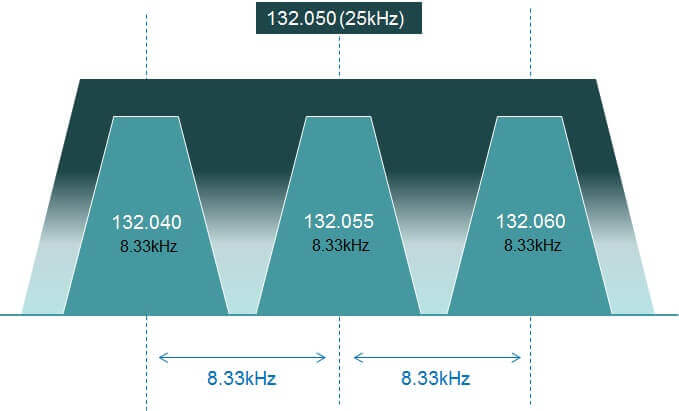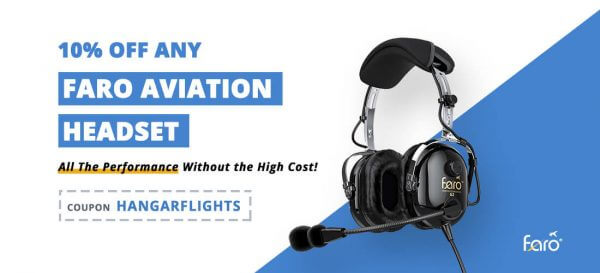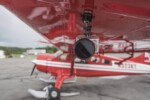The 7 Best Handheld Aviation Radios for Pilots in 2025
6 July 2021 | Updated on January 06, 2025
When it comes to aviation, communication is key. Pilots need reliable, clear, and efficient communication tools for a safe flight. Among these tools, a handheld aviation radio stands out as essential.
Whether you’re communicating with air traffic control, receiving weather updates, or even in an emergency situation where the main onboard systems fail, a good handheld radio is your lifeline. And not only does it improve safety, but it can also be a great money-saving tool on the ground for (student) pilots.
The perfect radio ensures clear, dependable communication, keeping you connected in all flight situations. But with so many different models available today, it’s not easy to determine which model will be best for your needs.
In this guide, we’ll discuss some important things to keep in mind when looking for a radio, and we list some of the best aviation handheld radios available today. Let’s dive in!
We’ve also included a full buying guide at the bottom of this article.
The Best Aviation COMM-only Handheld Radios in 2025
If you’re looking for a basic handheld aviation radio, then a ‘simple’ comm-only radio will do the job just fine. These portable radios offer basic communication functionality and are a great tool for any pilot’s flight bag.
1. Yaesu FTA-450L
$231.20
The Yaesu FTA-450L is a competitively priced (COMM-ONLY) version of the wildly successful FTA-550L (mentioned further down below). With a 1.7″ x 1.7″ screen, it’s easy to operate and offers 200 programmable channels to store and retrieve your favorite channels quickly.
The Yaesu FTA-450L handheld aviation radio shines in several aspects. We’re particularly impressed with its large, easy-to-read display, which simplifies operation during flight. Coupled with a rugged build quality, it’s ready to withstand the rough-and-tumble environment of the cockpit, all while being budget-friendly, offering excellent value for your investment.
However, the radio isn’t without its shortcomings. The antenna has a tendency to loosen over time, which could affect signal quality and durability. Programming channels might give you a bit of a headache, as the process isn’t as user-friendly as we’d like. Finally, the headset plug dust cover design leaves room for improvement. Instead of a quick and easy rubber cover, it uses screws, making access more time-consuming and fiddly than necessary.
2. Icom IC-A16
$297.99
The Icom IC-A16 is a worthy successor to the IC-A14 and IC-A15, packing a punch with its compact design and powerful speaker. This radio stands out for its one-handed operation, making it perfect for use on the flight line, as an in-flight backup, or by ground crew. It’s robustly built with an IP67 waterproof rating, and its 2400mAh Li-ion battery provides over 17 hours of operation. When it comes to audio performance, the IC-A16 doesn’t disappoint. Its internal speaker delivers a potent 1500mW audio output, ensuring clear sound that cuts through the cabin or tarmac noise.
Despite its impressive features, the IC-A16 isn’t without a few drawbacks. The display might be challenging to read under bright sunlight, and the menu system might take a bit of time to master due to its complexity. Nonetheless, the quality, compactness, waterproofing, loud audio, and user-friendly design make it a solid choice for any pilot.
3. Icom IC-A25C
$508.98
Icom’s IC-A25C is the latest addition to their range of handheld aviation radios, bringing power and durability to your fingertips. With a hefty 6 watts of power, it’s designed to keep you connected no matter what. Add in an IP57 waterproof rating, and you’ve got a radio that’s ready to face any weather condition. What’s more, it boasts a sizeable 2350mAh Li-ion battery, ensuring a long operating time and less worry about mid-flight power loss.
The IC-A25C is designed with simplicity and ease-of-use in mind. Its large 2.3-inch LCD display and intuitive interface ensure stress-free programming and operation, even when you’re soaring at high altitudes. However, it’s worth noting that this model, unlike its navigation counterpart, does not come with Bluetooth functionality – a feature we wish was included given its higher price point. Its standout feature is the large, easy-to-read screen, but the tradeoff is its cost and lack of Bluetooth. Despite these drawbacks, the Icom IC-A25C remains a strong contender for its raw power and user-friendly design.
The Best Aviation COMM/NAV Handheld Radios in 2025
If you’re looking for a backup navigational device, then a handheld radio with navigation capabilities can be an excellent choice.
These radios can offer features such as VOR and ILS tracking, with some even including GPS functionality. A great way to have a navigation backup with you at all times!
1. Yaesu FTA-550L
$298.98
The Yaesu FTA-550L is a feature-rich aviation radio that offers great value for its price. Sporting a large, full dot-matrix LCD display, it ensures easy readability even in flight. This device offers comprehensive coverage of the Aircraft Communications Band, ensuring you’re connected when it matters most. But it’s not just about communication – the FTA-550L also brings navigational features to the table with VOR and localizer capabilities on the “NAV” band. It doesn’t stop there either – it includes NOAA weather band monitoring, making it easy to stay updated on weather conditions. You’ll also appreciate the convenience of up to 200 programmable memory channels with a quick recall feature. As for durability, its rugged build quality stands up to the rigors of regular use.
The FTA-550L shines in terms of price-performance ratio, giving comparable Icom radios a run for their money. Additionally, it comes with a headset adapter, a handy extra. However, it’s not all smooth sailing. Its headset plug dust cover uses screws, which can be less convenient than a rubber cover. Also, take note, this model doesn’t offer Bluetooth connectivity, which could be a downside if you’re looking for wireless convenience. But overall, the Yaesu FTA-550L is a reliable, feature-packed choice for those on a budget.
2. Yaesu FTA-750L (GPS)
$394.00
The Yaesu FTA-750L is a top-tier handheld aviation radio packed with advanced features, a step up from its sibling, the FTA-550L. This device is more than just a compact transceiver; it’s an all-in-one flight companion offering a comprehensive aviation COM/NAV radio, NOAA weather channels and alerts, VOR and ILS/glideslope navigation, and a 66-channel GPS WAAS receiver. If you want a radio that does more than just keep you connected, one that provides navigational support and even built-in GPS, the FTA-750L should be on your radar.
This radio checks a lot of boxes for pilots. Its large, easy-to-read screen and Bluetooth connectivity enhance user experience, while its rugged build ensures durability. Uniquely, it provides excellent value for its price, coming in cheaper than comparable Icom models, and it comes with a headset adapter, adding to its value. However, there’s a minor gripe about its design – the headset plug dust cover uses screws, which can be a bit inconvenient compared to the standard rubber cover. But that’s a small drawback in an otherwise superb device.
3. Yaesu FTA-850L (GPS)
$425.97 $463.10
Unveiling Yaesu’s recent crown jewel, the FTA-850L. This handheld aviation radio, engineered with the needs of top aviators in mind, features a generous 2.4″ full-color display and a treasure trove of sought-after features. It boasts capabilities like ILS, VOR, GPS, and an impressive memory bank capable of storing 400 channels. It even has Bluetooth functionality. And with its robust 2200mAh Lithium-Ion battery – an upgrade from previous models – you can trust it won’t fail you when it matters most.
The standout feature of the FTA-850L is undeniably its GPS navigation, beautifully rendered on the bright, full-color display. With the Flight Route Navigation feature, you can visualize your entire travel route, complete with all waypoints between your departure and destination. This means your route, location, and travel status can be assessed in a single glance. This radio’s build is as robust as its feature set, making it an ideal backup for all cockpit navigation systems. We appreciated the vibrant display, larger battery, massive memory bank, PC programmability, and loud speaker. However, we did notice the headset plug dust cover uses screws rather than a more convenient rubber cover. Despite this minor flaw, the FTA-850L holds its own as one of the best options currently on the market.
We have just ordered this radio ourselves; once it arrives and we got a chance to test it extensively, you can expect a full review on Hangar.Flights!
4. Icom IC-A25N
$593.93
The Icom IC-A25N is a heavyweight contender in the world of handheld aviation radios. This high-powered NAV-COM handheld, with its robust 6 watts of power, is an all-weather friend thanks to its IP57 waterproof rating. The device packs a hefty 2350mAh Li-ion battery, ensuring a long runtime that’ll see you through extended operations. The A25N goes beyond just communication and takes navigation head-on with built-in GPS and VOR capabilities. Even with all these features, ease of use is not compromised. A large 2.3-inch LCD display coupled with an intuitive interface ensures stress-free programming and in-flight operation. And let’s not forget the cherry on top – built-in Bluetooth for added convenience and connectivity.
However, quality and features come at a price, making the Icom IC-A25N a pricier option on our list. Additionally, users have reported that it’s somewhat sensitive to being knocked off frequency. Nevertheless, for its crystal-clear display, solid build, navigation features, and impressive power, it’s a radio that earns its place in the cockpit.
Why do you need a Handheld Aviation Radio?
“You’ve got radios in the cockpit, right? Why another one?” you may ask.
Well, picture this: you’re up in the air, and bam! Your trusty panel-mounted radios decide to go silent. What now? This is where your handheld hero swoops in. It’s your plan B, your reliable wingman that ensures you’re never left without a lifeline to ATC and fellow pilots. Its portability makes it a favorite for those who value the safety net it provides, especially when their built-in radios can’t play their part.
Now, imagine you’re renting a plane, and that meter is ticking before you even start your engines. Time is money, and every minute you spend getting the ATIS report with the engine running, the bill climbs. With a handheld radio, you can get the info you need before you ever turn the key, cutting those precious minutes off your tab. If you fly rentals frequently, the savings you make can quickly cover the cost of a decent handheld radio.
Bottom line, a portable radio is more than just an accessory. For any pilot, it’s a smart investment that pays dividends not only in peace of mind but also in real dollars by trimming down engine hours and fuel costs during preflight comms.
Things to consider when buying a (new) Handheld Aviation Radio
When looking for a handheld aviation radio, there are a few factors to consider and look out for.
Receiver/Transceiver
This might speak for itself, but always watch out for the very cheap radios; they are usually receivers (not transceivers), that you can use to receive radio transmissions only. If your only intention is to listen to ATC conversations, a receiver would do the job just fine.
However, if you’re really looking for a good handheld alternative to your aircraft’s radio, a handheld aviation transceiver is what you need.
Comm/Nav
Most radios are sold in two different models; The inexpensive model is usually COMM-only, with the more expensive one also offering navigation functionalities. This NAV function is usually able to track VOR’s and even ILS, and could be helpful as a backup when flying IFR. Recently, some of the newer models are equipped with a built-in GPS as well, to offer an even more valuable tool.
Batteries
The type of battery a radio uses can affect how often it needs to be charged as well as its overall size and weight- ask yourself if these factors matter most when choosing which radio would suit you best.
Most handheld radios now use lithium-ion batteries, which can be recharged without replacing them. There are some models that come with a battery pack using AA batteries; make sure to periodically check the battery life and replace them when needed.
25/8,33 kHz
If you’re flying in the EU, this is something very important to keep in mind. Since 2018, EU regulations have changed the spacing of the frequencies to 8,33 kHz, meaning for every single old frequency, there can now be three new ones. As a result, EU pilots are required to use radios that support 8,33 kHz spacing, making the older 25 kHz radios obsolete. Keep this in mind so you can operate your radio legally inside the EU and potentially other countries that might follow in the near future.
All radios mentioned in this guide support the 8,33 kHz narrow band.


More about the 8.33 kHz implementation can be found on Eurocontrol’s website.
Frequency Ranges
Handheld air band radios are designed to receive and transmit on the VHF (Very High Frequency) bands. If you purchase a com-only radio, it will operate at frequencies between 118.000 – 136.975 MHz (MHz – megahertz). However, if your radio also features navigation capabilities, it will have an additional range between 108.000 – 117.975 mHz.
Many models also include weather channels (between 161 and 164 mHz) and can automatically transmit on the International Air Distress (IAD) frequency, 121.500 mHz, using a dedicated button on the radio.
Durability
Durability is an important factor when choosing a handheld aviation radio, especially given the demanding environment of aviation. A good aviation radio should be robust enough to withstand the bumps and bruises of a pilot’s life. Look for models that promise durability and have solid build quality.
When it comes to durability, pay close attention to the following elements:
- Build Quality: The radio should feel sturdy in your hand.
- Shock Resistance: Accidents happen. Whether it’s a drop from a cockpit shelf or a rough ride in a flight bag, your radio needs to withstand its fair share of knocks and falls.
- Water Resistance: While we certainly don’t anticipate your radio going for a swim, resistance to moisture (from rain, humidity, or even a spilled drink) can be a real lifesaver.
- Longevity of Buttons and Controls: The most frequently used parts of your radio are the buttons and knobs.
- Quality of the Antenna: The antenna is a crucial part of the radio that can often be overlooked. A sturdy, well-constructed antenna not only provides better performance but also stands up to regular use and accidental bumps without breaking or bending.
- Warranty: Finally, consider the warranty offered by the manufacturer. A longer warranty period often indicates confidence in the product’s durability and gives you some security if something should go wrong.
User Reviews
A good way to determine the quality and suitability of an aviation radio is by reading customer reviews. Check the reviews to see what other pilots have said about their experience with these radios. That way, you’ll quickly find out what to expect and which models are the best aviation handheld radios to purchase.


Remember, the perfect handheld aviation radio for you will largely depend on your specific needs, preferences, and budget. Keep these factors in mind, and you’ll be well on your way to finding your ideal sky companion.
Now, let’s dive into the main part of this article: the different aviation radios available today. We divided them into 2 different sections; the first one covering comm-only handheld radios, and secondly the handheld radios with navigation capabilities as well.
2025 Aviation Handheld Radios Comparison Table
Below you will find a full comparison table between both Icom’s and Yaesu’s models. This should help you make an informed decision!
  |
  |
  |
  |
  |
  |
  |
  |
  | |
| Icom IC-A16 | Icom IC-A16B with Bluetooth | Icom IC-A25C | Icom IC-A25N | Yaesu FTA-250L | Yaesu FTA-450L | Yaesu FTA-550L | Yaesu FTA-750L | Yaesu FTA-850L | |
| Manufacturer | Icom | Icom | Icom | Icom | Yaesu | Yaesu | Yaesu | Yaesu | Yaesu |
| Specifications | |||||||||
| Size (inches) | 2.1" x 4.4" x 1.3" | 2.1" x 4.4" x 1.3" | 2.3" x 5.8" x 1.3" | 2.3" x 5.8" x 1.3" | 2.1" x 4.1" x 1.2" | 2.4" x 5.2" x 1.3" | 2.4" x 5.2" x 1.3" | 2.4" x 5.2" x 1.3" | 5.91" x 2.56" x 1.57" |
| Weight (ounces) | 9.1 | 9.1 | 13.6 | 13.6 | 10.6 | 14.5 | 14.5 | 14.5 | 13.9 |
| Battery type | 2400mAh Lithium-Ion | 2400mAh Lithium-Ion | 2350mAh Lithium-Ion | 2350mAh Lithium-Ion | 1950mAh Lithium-Ion | 2000mAh Lithium-Ion | 2000mAh Lithium-Ion | 2000mAh Lithium-Ion | 2200mAh Lithium-Ion |
| Water resistant | Yes | Yes | Yes | Yes | Yes | Yes | Yes | Yes | Yes |
| Submersible | IP67 Waterproof | IP67 Waterproof | 3 ft. up to 30 min. | 3 ft. up to 30 min. | IPX5 Water Spray | IPX5 Water Spray | IPX5 Water Spray | IPX5 Water Spray | IPX5 Water Spray |
| TX output | 6 watt | 6 watt | 6 watt | 6 watt | 5 watt | 5 watt | 5 watt | 5 watt | |
| Display | |||||||||
| Display type | LCD | LCD | LCD | LCD | LCD | Dot Matrix | Dot Matrix | Dot Matrix | TFT Color Display |
| Display size (inches) | .375" x 1.125" | .375" x 1.125" | 1.5" x 2.0" | 1.5" x 2.0" | .5" x 1.38" | 1.7" x 1.7" | 1.7" x 1.7" | 1.7" x 1.7" | 2.4" |
| Backlighting | Yes | Yes | Yes | Yes | Yes | Yes | Yes | Yes | Yes |
| Functions | |||||||||
| VOR | No | No | No | Yes | No | No | Yes | Yes | Yes |
| CDI | No | No | No | Yes | No | No | Yes | Yes | Yes |
| GPS | No | No | No | Yes | No | No | No | Yes | Yes |
| ILS localizer | No | No | No | No | No | No | Yes | Yes | Yes |
| ILS glideslope | No | No | No | No | No | No | No | Yes | Yes |
| Bluetooth | No | Yes | No | Yes | No | No | No | No | Yes |
| Flight planning apps | No | No | No | Yes | No | No | No | No | No |
| Automatic WX | No | No | No | No | Yes | Yes | Yes | Yes | Yes |
| Memory channels | 200 | 200 | 300 | 300 | 250 | 200 | 200 | 200 | 400 |
| Automatic noise limiter | Yes | Yes | Yes | Yes | Yes | Yes | Yes | Yes | Yes |
| Direct 121.5 mHz access | Yes | Yes | Yes | Yes | Yes | Yes | Yes | Yes | Yes |
| Channel spacing | 25kHz/8.33kHz | 25kHz/8.33kHz | 25kHz/8.33kHz | 25kHz/8.33kHz | 25kHz/8.33kHz | 25kHz/8.33kHz | 25kHz/8.33kHz | 25kHz/8.33kHz | 25kHz/8.33kHz |
| Accessories | |||||||||
| Rechargable battery | Included | Included | Included | Included | Included | Included | Included | Included | Included |
| Battery charger | Included | Included | Included | Included | Included | Included | Included | Included | Included |
| Headset adapter | Optional | Optional | Included | Included | Included | Included | Included | Included | Included |
| Alkaline battery case | No | No | Optional | Optional | No | Included | Included | Included | Included |
| Cigarette lighter adapter | Optional | Optional | Optional | Optional | Included | Included | Included | Included | Included |
| Belt clip | Included | Included | Included | Included | Included | Included | Included | Included | Included |
| Other | |||||||||
| Warranty | 3 years | 3 years | 3 years | 3 years | 3 years | 3 years | 3 years | 3 years | 3 years |
| Buy now on Amazon | Buy now on Amazon | Buy now on Amazon | Buy now on Amazon | Buy now on Amazon | Buy now on Amazon | Buy now on Amazon | Buy now on Amazon | Buy now on Amazon |
Not quite sure whether you need a Yaesu or Icom handheld radio? Check out our extensive comparison guide here!
Conclusion
When shopping for a handheld aviation radio, it’s important to consider what exactly it is you need. If you’re looking for a simple handheld aviation radio to use as a backup, then a COMM-only radio is usually sufficient. If you’re planning on using it as a backup navigational device as well, NAV functionality might be worth the additional investment.
All in all, the best aviation handheld radios for you will depend on your personal needs and budget. Good luck!
































